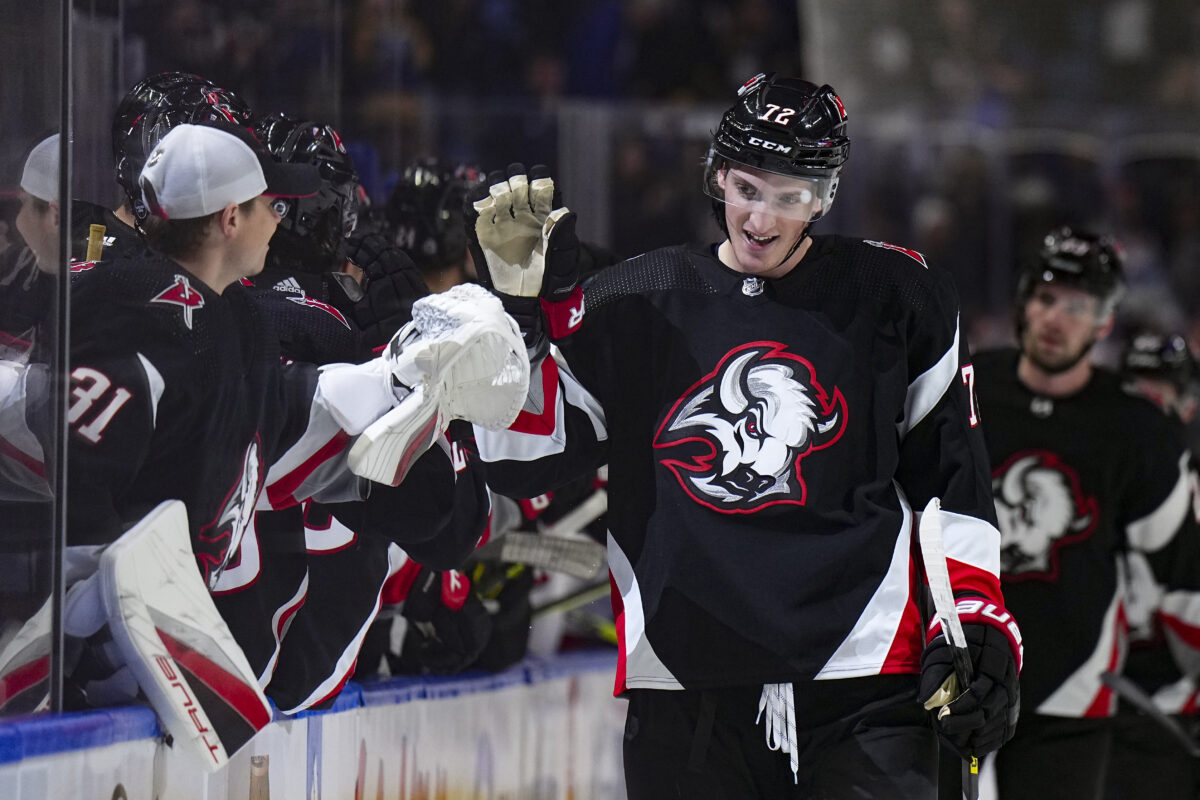Through five games, the Buffalo Sabres’ saving grace from last season has been absent — just 13 goals have entered the net for the offense, extrapolating to one less goal per game than they scored last season. Part of this issue has been a lack of production from the top line of Tage Thompson, Jeff Skinner, and Alex Tuch. The trio has combined for three goals and two assists, with Skinner being responsible for two and one, respectively. The line’s lack of success culminated in a line blender in their last game, with Skinner and Tuch moving down to the second line with Casey Mittelstadt, and Dylan Cozens and Jordan Greenway heading to Thompson’s wings.
Thompson’s slow start in particular has caused some grief from fans, and rightfully so. The star’s expectations were sky-high considering the development arc he’s shown over the past two seasons. Just one goal and one point through five games is the last thing that anyone expected. Still, though, there are more reasons to be optimistic that he’ll return to form sooner rather than later than to assume the worst through a small sample size.
Underlying Statistics
In his 78 games last season, Thompson posted an individual expected-goals (ixG) total of 30.39 as per Natural Stat Trick. The season before, he had an ixG of 23.22. Being that his actual goal totals were 47 and 38, respectively, it’s more than reasonable to conclude that he’s a well-above league average finisher who should continue the trend of scoring above his expected rate. Thus far into the season, Thompson has an ixG of 1.84 and just one goal.

On the same token is his individual scoring chances for (iSCF). Last season, Thompson averaged 3.83 iSCF per game for a total of 299 scoring chances. This season, he’s put up 21 iSCF through the first five games, giving him a game-to-game average of 4.2. Between his ixG and his iSCF this season in comparison to his prior rates, the natural conclusion is that he’s too good a finisher and producing too many chances for his goal total not to explode sooner rather than later.
Past the individual statistics, Thompson’s 5-on-5 expected goals rate (xGF%) is far above his career average in the five games this season, indicating that positive regression is surely on its way. In the last two seasons, his xGF% has floated right around 50%, with one season on either side of the halfway point. This season, though, he’s sported an xGF% of 63.45%, meaning that his team has controlled 63.45% of the expected goals when he’s on the ice at even strength. This isn’t to suggest that he’ll surpass his point total from last season (94), but it is certainly reason to assume this is just a fluke beginning to his year. His one goal and zero assists are anomalous considering his underlying metrics.
Related: Sabres’ Rookie Benson Shows Early Promise
Latest THW Headlines
Then, there’s the luck factor. To statistically determine “puck luck,” one can look at a player’s PDO — a combination of save percentage (SV%) and shooting percentage (S%) at even strength. On a league-wide scale, PDO will always equal exactly 1.00 — any given shot either hits the back of the net or it doesn’t. Thus, a player (or team) that has a PDO over 1.00 is considered somewhat “lucky,” and should expect regression, whereas a player or team under 1.00 will more likely than not experience the opposite effect. A very low PDO is considered to be around .98 — 2% below league average. Thompson’s PDO this year? 0.918, 8.2% below league average. For comparison’s sake, last season, Thompson sported a PDO of 1.011, and the year prior a .997.
In fact, Thompson is among the unluckiest players in the league this season at even strength. Among forwards with at least 60 minutes at 5-on-5, Thompson’s PDO ranks 149th of 166 forwards — making him the 17th unluckiest forward in the NHL according to this statistic. A more offense-oriented look at this statistic shows that the real issue is with the Sabres’ on-ice shooting percentage (oiSH%) while he’s on the ice. oiSH% supports the idea that an individual player’s statistics are dependent on his teammates to some extent. Hypothetically, if he were to garner an oiSH% of exactly 10%, that implies that all of his teammates score on 10% of their shots whenever he is on the ice. A high oiSH% would likely result in more points for that individual player simply on the basis that his team scores a lot of goals when he’s actively playing.

Thompson’s oiSH% in the past two seasons was 10.79% and 11.32%, respectively. This season, though early, he has an oiSH% of 4.35%, once again proving that he and his teammates have been incredibly unlucky with potting goals in comparison to their usual rate. While his goal total in and of itself is surprising, the fact that he doesn’t have an assist to his name yet this season is equally as perplexing.
Thompson Will Regress to the Mean
The above metrics effectively all result in the conclusion that Thompson has been one of the unluckiest players in the league, especially considering his skill level in comparison to a lot of the players who could be labeled as “unlucky.” The fact that his linemates have all experienced some level of luck hindering their production only furthers this argument. The Sabres’ top line as a whole is simply too talented to continue this level of production (or lack thereof). Sooner rather than later, their performance — Thompson’s in particular — will take a U-turn.
